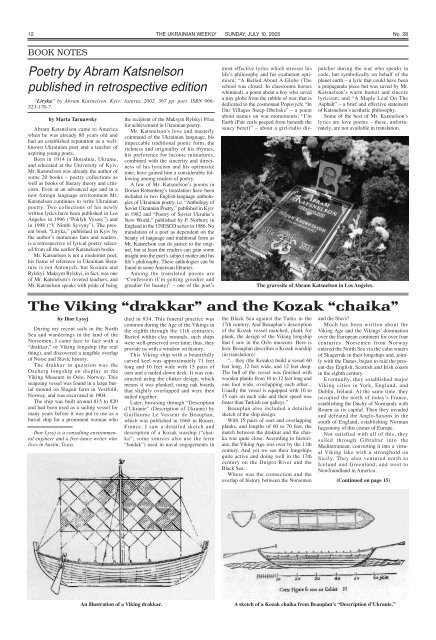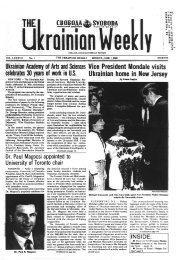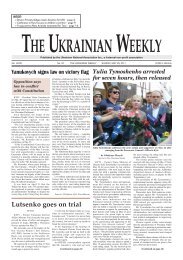12 THE UKRAINIAN WEEKLY SUNDAY, JULY 10, 2005No. 28BOOK NOTESPoetry by Abram Katsnelsonpublished <strong>in</strong> retrospective edition“Liryka” by Abram Katsnelson. Kyiv: Astarta, 2002. 367 pp. port. ISBN 966-523-170-7.by Marta TarnawskyAbram Katsnelson came to Americawhen he was already 80 years old andhad an established reputation as a wellknown<strong>Ukra<strong>in</strong>ian</strong> poet and a teacher <strong>of</strong>aspir<strong>in</strong>g young poets.Born <strong>in</strong> 1914 <strong>in</strong> Horodnia, Ukra<strong>in</strong>e,and educated at the University <strong>of</strong> Kyiv,Mr. Katsnelson was already the author <strong>of</strong>some 20 books – poetry collections aswell as books <strong>of</strong> literary theory and criticism.Even at an advanced age and <strong>in</strong> anew foreign language environment Mr.Katsnelson cont<strong>in</strong>ues to write <strong>Ukra<strong>in</strong>ian</strong>poetry. Two collections <strong>of</strong> his newlywritten lyrics have been published <strong>in</strong> LosAngeles <strong>in</strong> 1996 (“Poklyk Vysoty”) and<strong>in</strong> 1998 (“V Nimbi Syvyny”). The presentbook “Liryka,” published <strong>in</strong> Kyiv bythe author’s numerous fans and readers,is a retrospective <strong>of</strong> lyrical poetry selectedfrom all the earlier Katsnelson books.Mr. Katsnelson is not a modernist poet;his frame <strong>of</strong> reference <strong>in</strong> <strong>Ukra<strong>in</strong>ian</strong> literatureis not Antonych, but Sosiura andRylskyi. Maksym Rylskyi, <strong>in</strong> fact, was one<strong>of</strong> Mr. Katsnelson’s revered teachers, andMr. Katsnelson speaks with pride <strong>of</strong> be<strong>in</strong>gthe recipient <strong>of</strong> the Maksym Rylskyi Prizefor achievement <strong>in</strong> <strong>Ukra<strong>in</strong>ian</strong> poetry.Mr. Katsnelson’s love and masterlycommand <strong>of</strong> the <strong>Ukra<strong>in</strong>ian</strong> language, hisimpeccable traditional poetic form, therichness and orig<strong>in</strong>ality <strong>of</strong> his rhymes,his preference for laconic m<strong>in</strong>iatures,comb<strong>in</strong>ed with the s<strong>in</strong>cerity and directness<strong>of</strong> his lyricism and his optimistictone, have ga<strong>in</strong>ed him a considerable follow<strong>in</strong>gamong readers <strong>of</strong> poetry.A few <strong>of</strong> Mr. Katsnelson’s poems <strong>in</strong>Dorian Rottenberg’s translation have been<strong>in</strong>cluded <strong>in</strong> two English-language anthologies<strong>of</strong> <strong>Ukra<strong>in</strong>ian</strong> poetry, i.e. “Anthology <strong>of</strong>Soviet <strong>Ukra<strong>in</strong>ian</strong> Poetry,” published <strong>in</strong> Kyiv<strong>in</strong> 1982 and “Poetry <strong>of</strong> Soviet Ukra<strong>in</strong>e’sNew World,” published by P. Norbury <strong>in</strong>England <strong>in</strong> the UNESCO series <strong>in</strong> 1986. Notranslation <strong>of</strong> a poet as dependent on thebeauty <strong>of</strong> language and traditional form asMr. Katsnelson can do justice to the orig<strong>in</strong>al,but at least the readers can ga<strong>in</strong> some<strong>in</strong>sight <strong>in</strong>to the poet’s subject matter and hislife’s philosophy. These anthologies can befound <strong>in</strong> some American libraries.Among the translated poems are“Confession (I’m gett<strong>in</strong>g greedier andgreedier for beauty)” – one <strong>of</strong> the poet’smost effective lyrics which stresses hislife’s philosophy and his exuberant optimism;“A Ballad About A Globe (Theschool was closed. In classrooms horseswh<strong>in</strong>nied), a poem about a boy who saveda t<strong>in</strong>y globe from the rubble <strong>of</strong> war, that isdedicated to the cosmonaut Popovych; “InOur Villages Steep Obelisks” – a poemabout names on war monuments; “I’mEarth (Fair curls peeped from beneath thesaucy beret)” – about a girl-radio dispatcherdur<strong>in</strong>g the war who speaks <strong>in</strong>code, but symbolically on behalf <strong>of</strong> theplanet earth – a lyric that could have beena propaganda piece but was saved by Mr.Katsnelson’s warm humor and s<strong>in</strong>cerelyricism; and “A Maple Leaf On TheAsphalt” – a brief and effective statement<strong>of</strong> Katsnelson’s aesthetic philosophy.Some <strong>of</strong> the best <strong>of</strong> Mr. Katsnelson’slyrics are love poems – these, unfortunately,are not available <strong>in</strong> translation.The gravesite <strong>of</strong> Abram Katsnelson <strong>in</strong> Los Angeles.The Vik<strong>in</strong>g “drakkar” and the Kozak “chaika”by Ihor LysyjDur<strong>in</strong>g my recent sails <strong>in</strong> the NorthSea and wander<strong>in</strong>gs <strong>in</strong> the land <strong>of</strong> theNorsemen, I came face to face with a“drakkar,” or Vik<strong>in</strong>g longship (the realth<strong>in</strong>g), and discovered a tangible overlap<strong>of</strong> Norse and Slavic history.The drakkar <strong>in</strong> question was theOseberg longship on display at theVik<strong>in</strong>g Museum <strong>in</strong> Oslo, Norway. Thisseago<strong>in</strong>g vessel was found <strong>in</strong> a large burialmound on Slagen farm <strong>in</strong> Vestfold,Norway, and was excavated <strong>in</strong> 1904.The ship was built around 815 to 820and had been used as a sail<strong>in</strong>g vessel formany years before it was put to use as aburial ship for a prom<strong>in</strong>ent woman whoIhor Lysyj is a consult<strong>in</strong>g environmentaleng<strong>in</strong>eer and a free-lance writer wholives <strong>in</strong> Aust<strong>in</strong>, Texas.died <strong>in</strong> 834. This funeral practice wascommon dur<strong>in</strong>g the Age <strong>of</strong> the Vik<strong>in</strong>gs <strong>in</strong>the eighth through the 11th centuries.Buried with<strong>in</strong> clay mounds, such shipswere well-preserved over time; thus, theyprovide us with a w<strong>in</strong>dow on history.This Vik<strong>in</strong>g ship with a beautifullycarved keel was approximately 71 feetlong and 16 feet wide with 15 pairs <strong>of</strong>oars and a nailed-down deck. It was constructedus<strong>in</strong>g the cl<strong>in</strong>ker design, whichmeans it was planked, us<strong>in</strong>g oak boardsthat slightly overlapped and were thennailed together.Later, brows<strong>in</strong>g through “Descriptiond’Ukranie” (Description <strong>of</strong> Ukra<strong>in</strong>e) byGuillaume Le Vasseur de Beauplan,which was published <strong>in</strong> 1660 <strong>in</strong> Rouen,France, I saw a detailed sketch anddescription <strong>of</strong> a Kozak warship (“chaika”;some sources also use the term“baidak”) used <strong>in</strong> naval engagements <strong>in</strong>the Black Sea aga<strong>in</strong>st the Turks <strong>in</strong> the17th century. And Beauplan’s description<strong>of</strong> the Kozak vessel matched, plank forplank, the design <strong>of</strong> the Vik<strong>in</strong>g longshipthat I saw <strong>in</strong> the Oslo museum. Here ishow Beauplan describes a Kozak warship(<strong>in</strong> translation):“... they (the Kozaks) build a vessel 60feet long, 12 feet wide, and 12 feet deep.The hull <strong>of</strong> the vessel was f<strong>in</strong>ished withwooden planks from 10 to 12 feet long andone foot wide, overlapp<strong>in</strong>g each other...Usually the vessel is equipped with 10 to15 oars on each side and their speed wasfaster than Turkish oar galleys.”Beauplan also <strong>in</strong>cluded a detailedsketch <strong>of</strong> the ship design.With 15 pairs <strong>of</strong> oars and overlapp<strong>in</strong>gplanks, and lengths <strong>of</strong> 60 to 70 feet, thematch between the drakkar and the chaikawas quite close. Accord<strong>in</strong>g to historians,the Vik<strong>in</strong>g Age was over by the 11thcentury. And yet we see their longshipsquite active and do<strong>in</strong>g well <strong>in</strong> the 17thcentury on the Dnipro River and theBlack Sea.Where was the connection and theoverlap <strong>of</strong> history between the Norsemenand the Slavs?Much has been written about theVik<strong>in</strong>g Age and the Vik<strong>in</strong>gs’ dom<strong>in</strong>ationover the European cont<strong>in</strong>ent for over fourcenturies. Norsemen from Norwayentered the North Sea via the calm waters<strong>of</strong> Skagerrak <strong>in</strong> their longships and, jo<strong>in</strong>tlywith the Danes, began to raid the present-dayEnglish, Scottish and Irish coasts<strong>in</strong> the eighth century.Eventually, they established majorVik<strong>in</strong>g cities <strong>in</strong> York, England, andDubl<strong>in</strong>, Ireland. At the same time, theyoccupied the north <strong>of</strong> today’s France,establish<strong>in</strong>g the Duchy <strong>of</strong> Normandy withRouen as its capital. Then they <strong>in</strong>vadedand defeated the Anglo-Saxons <strong>in</strong> thesouth <strong>of</strong> England, establish<strong>in</strong>g Normanhegemony <strong>of</strong> this corner <strong>of</strong> Europe.Not satisfied with all <strong>of</strong> this, theysailed through Gibraltar <strong>in</strong>to theMediterranean, convert<strong>in</strong>g it <strong>in</strong>to a virtualVik<strong>in</strong>g lake with a stronghold onSicily. They also ventured north toIceland and Greenland, and west toNewfoundland <strong>in</strong> America.(Cont<strong>in</strong>ued on page 15)An illustration <strong>of</strong> a Vik<strong>in</strong>g drakkar.A sketch <strong>of</strong> a Kozak chaika from Beauplan’s “Description d’Ukranie.”
No. 28by Ruslan Belikov“I should disclose and publish to theworld the occasion <strong>of</strong> discover<strong>in</strong>g andobserv<strong>in</strong>g four planets, never seen fromthe beg<strong>in</strong>n<strong>in</strong>g <strong>of</strong> the world up to our owntimes, their positions, and the observations...abouttheir movements and theirchanges <strong>of</strong> magnitude; and I summon allastronomers to apply themselves toexam<strong>in</strong>e and determ<strong>in</strong>e their periodictimes...”– Galileo Galilei, March 1610Thus spoke Galileo Galilei, the firstperson <strong>in</strong> history to po<strong>in</strong>t a telescope upat the heavens and record his observations.The four planets he spoke about arethe four largest moons <strong>of</strong> Jupiter, subsequentlynamed Galilean moons. Theimpact <strong>of</strong> see<strong>in</strong>g these objects wasgreater than this quote alone would suggest.Galileo’s observation has dethronedthe Earth from be<strong>in</strong>g unique: here are, forthe first time <strong>in</strong> history, heavenly bodiesthat are manifestly orbit<strong>in</strong>g someth<strong>in</strong>gother than the Earth, which was held tobe the center <strong>of</strong> the universe <strong>in</strong> thosetimes.Fast-forward four centuries.S<strong>in</strong>ce the humble beg<strong>in</strong>n<strong>in</strong>gs <strong>of</strong> telescopicastronomy <strong>in</strong> Galileo’s hands,humanity has built telescopes 10 meters<strong>in</strong> diameter on the ground and put severalsmaller ones <strong>in</strong> space. Not only hasthe Earth been dethroned as be<strong>in</strong>g thecenter <strong>of</strong> the universe, but so has thesun, and the Milky Way galaxy. In fact,the very matter that comprises us andeveryth<strong>in</strong>g we observe is not even thema<strong>in</strong> “stuff” <strong>of</strong> the universe – the majorityis the puzzl<strong>in</strong>g “dark matter” and“dark energy.”Surpris<strong>in</strong>gly, one <strong>of</strong> the last th<strong>in</strong>gsthat was dethroned is the uniqueness <strong>of</strong>our sun’s planetary system. To be sure,there was little doubt other stars haveplanets, but there was no factual pro<strong>of</strong><strong>of</strong> this until quite recently. The firstdef<strong>in</strong>itive extra-solar planet (around ama<strong>in</strong>-sequence star) was announcedonly <strong>in</strong> 1995 by Michel Mayor andDidier Queloz, University <strong>of</strong> Geneva.S<strong>in</strong>ce then, the last decade has seen anexplosion <strong>of</strong> new extra-solar planet discoveries:over 150 have been found todate.However, all these planets are big,Jupiter-like gas giants (except<strong>in</strong>g perhapssome pulsar planets and one veryrecent f<strong>in</strong>d), necessarily so becausehumanity’s feeble <strong>in</strong>struments can onlydetect the largest <strong>of</strong> worlds. These behemothsare <strong>in</strong>capable <strong>of</strong> susta<strong>in</strong><strong>in</strong>g life aswe know it and seem just as alien andbarren to us as our own Jupiter. TheEarth is still the center <strong>of</strong> the universe <strong>in</strong>the sense that, as far as we know, it is thecenter <strong>of</strong> life. At present, any analogueto Earth can be found only <strong>in</strong> the pages<strong>of</strong> science fiction. The ultimate discovery<strong>of</strong> another Earth-like world wouldTHE UKRAINIAN WEEKLY SUNDAY, JULY 10, 2005 13Detect<strong>in</strong>g extra-solar earths: NASA’s Terrestrial Planet F<strong>in</strong>der missionDr. Ruslan Belikov was born <strong>in</strong> Kyivand came to the United States <strong>in</strong> 1991.He received his Ph.D. from StanfordUniveristy <strong>in</strong> 2004, and was awarded theMichelson Fellowship <strong>in</strong> 2005 fromNASA’s Jet Propulsion Laboratory toconduct research at Pr<strong>in</strong>cetonUniversity’s Terrestrial Planet F<strong>in</strong>derLaboratory. This article is based on alecture he delivered recently at a meet<strong>in</strong>g<strong>of</strong> the Mathematics-Physics-TechnicalSection <strong>of</strong> the Shevchenko ScientificSociety, <strong>of</strong> which he is a member. He maybe reached at rbelikov@pr<strong>in</strong>ceton.edu.For more <strong>in</strong>formation on TPF, please goto http://www.pr<strong>in</strong>ceton.edu/~tpf/ orhttp://planetquest.jpl.nasa.gov/TPF/tpf_<strong>in</strong>dex.html.herald a new era, an era <strong>in</strong> which Earthlikeplanets, be they barren or teem<strong>in</strong>gwith life, are known to exist elsewhere <strong>in</strong>the universe.Such a discovery may very well takeplace as early as 2015. If fund<strong>in</strong>g persistsand everyth<strong>in</strong>g goes on schedule,that year will see the launch <strong>of</strong> a NASAspace telescope called the TerrestrialPlanet F<strong>in</strong>der Coronagraph (TPF-C).This telescope will survey the nearestfew hundred stars that are most likely toharbor an Earth-like planet. It is unlikelythat we will actually f<strong>in</strong>d anadvanced civilization on those neighbor<strong>in</strong>gworlds (if one existed, we wouldsurely have picked up their radio broadcastsby now), but that is not the goal <strong>of</strong>the mission. The primary goal is to f<strong>in</strong>dplanets, life or no life, so that we canlearn more about our own Earth, just asa psychologist needs to study manypeople, big and small, young and old,man and woman, before he can trulyunderstand one. How common areEarth-like planets? How do they formand evolve? How diverse are they? Dothey harbor the conditions for life? Islife unique? If not, how common is it,how diverse, and how does it form?Ultimately, where did we come from?These are the questions we hope to shedlight on with TPF-C, appropriately apart <strong>of</strong> NASA’s Orig<strong>in</strong>s program. Theprice <strong>of</strong> gett<strong>in</strong>g those answers? An estimated$2 billion. An eyebrow-rais<strong>in</strong>gnumber, but yet it is less than a dollarper year per American for the next 10years. Th<strong>in</strong>k about that the next timeyou buy lunch!How can we answer these questionssimply by look<strong>in</strong>g at an image <strong>of</strong> a planet?To make matters worse, we will noteven get a resolved image <strong>of</strong> a planet,just a s<strong>in</strong>gle blurry speck, the best ourfeeble <strong>in</strong>struments could do.Nonetheless, there is a wealth <strong>of</strong> <strong>in</strong>formationthat can be teased out <strong>of</strong> that s<strong>in</strong>glespeck. One obvious parameter wewill be able to measure is its brightness,from which we can <strong>in</strong>fer an estimate <strong>of</strong>the planet’s size. We can also measurethe orbit and distance from the star,which would let us estimate the averagetemperature <strong>of</strong> the planet. If differentsides <strong>of</strong> the planet reflect differentamounts <strong>of</strong> light (as they do on Earthdue to the vary<strong>in</strong>g distribution <strong>of</strong> landmass),we will be able to measure periodicvariations <strong>in</strong> brightness as the planetrotates and thus measure the length <strong>of</strong>the day.A wealth <strong>of</strong> further <strong>in</strong>formation can berevealed from the spectrum <strong>of</strong> that s<strong>in</strong>glespeck, such as the presence <strong>of</strong> the atmosphereand its pressure, as well as theabundance <strong>of</strong> various compounds such asoxygen and water. If there is plant lifeand if it is anyth<strong>in</strong>g like that on Earth, itwill manifest itself via a characteristic<strong>in</strong>crease <strong>in</strong> reflectivity at <strong>in</strong>frared wavelengthscalled the “red edge.” In short,we will be far from bored with that onespeck.However, the actual detection <strong>of</strong> anEarth-like world is very difficult. Thereare two reasons for this. The ma<strong>in</strong> reasonis that the star is many times brighterthan the planet. As viewed from far away,our sun would be almost 10 10 , or 10 billiontimes brighter than Earth. This isabout as bright as a powerful searchlightwould appear next to a firefly. The secondreason is that the stars are so faraway, so that one needs very f<strong>in</strong>e resolv<strong>in</strong>gpower <strong>in</strong> a telescope. From one <strong>of</strong>our neighbor<strong>in</strong>g stars (say, 10 parsecsaway), our Earth would appear only 0.1arc seconds, or 0.0015 degrees awayfrom the sun. This would be equivalentto try<strong>in</strong>g to see the firefly buzz<strong>in</strong>g with<strong>in</strong>6 feet <strong>of</strong> our searchlight while star<strong>in</strong>gRoman Belikov (<strong>in</strong> front <strong>of</strong> screen) after his presentation at the ShevchenkoScientific Society with (from left) Roman Andrushkiw, Svitlana Andrushkiw,Volodymyr Petryshyn and Roman Voronka.directly at it from a distance <strong>of</strong> 2,600miles, or roughly New York to LosAngeles. As hard as it is to imag<strong>in</strong>e, thereare already <strong>in</strong>struments that meet each <strong>of</strong>the two requirements separately. Meet<strong>in</strong>gthese two requirements simultaneously isthe ma<strong>in</strong> technological challenge <strong>of</strong> themission.The terrestrial planet f<strong>in</strong>der missionTPF-C is be<strong>in</strong>g pursued by NASA’s JetPropulsion Laboratory (JPL) <strong>in</strong>Pasadena, Calif., along with a few subcontractedteams <strong>in</strong> academia and <strong>in</strong>dustry,our team at Pr<strong>in</strong>ceton Universitybe<strong>in</strong>g one <strong>of</strong> them. The TPF-C telescopewill have an elliptical primary mirror thatis roughly 8 by 3 meters, which providesthe necessary resolv<strong>in</strong>g power, and willimage <strong>in</strong> visible and near-<strong>in</strong>frared wavelengths.It will be placed <strong>in</strong> space toelim<strong>in</strong>ate the effects <strong>of</strong> atmospheric turbulence.(The reason the mirror is ellipticalis so it would fit <strong>in</strong>to the launch rocket!)However, even though the large mirrorsize lends the required resolution, aconventional telescope design will notprovide the required 10 10 contrast. Thereason for this is that <strong>in</strong> conventional telescopes,the star image is not a tightlyconf<strong>in</strong>ed dot or a circle, but, well, a“star” shape: it is an extended patternwith glare and perhaps four or morestreaks. An object not much dimmer thanthe star could be seen through this glare,but a planet that is 10 10 times dimmerwill be completely obscured. In order toreduce the glare, the back <strong>of</strong> the telescopewill conta<strong>in</strong> a special high-contrastsystem called the coronagraph (socalled because these were <strong>in</strong>itially conceivedfor observations <strong>of</strong> our sun’scorona).However, conventional coronagraphsare not powerful enough to achieve 10 10contrast, and new designs are be<strong>in</strong>gdeveloped. One promis<strong>in</strong>g design is theShaped-Pupil Coronagraph be<strong>in</strong>g pursuedby our group at Pr<strong>in</strong>cetonUniversity. The basic pr<strong>in</strong>ciple is this:the image <strong>of</strong> a star <strong>in</strong> a telescope is theso-called Po<strong>in</strong>t Spread Function (PSF),which is the Fourier Transform (FT) <strong>of</strong>the telescope open<strong>in</strong>g, the pupil.Typically, the PSF is not tightly localized,caus<strong>in</strong>g glare. The idea beh<strong>in</strong>d ourShaped-Pupil Coronagraph is to shapethe telescope open<strong>in</strong>g, or pupil, so thatits PSF is tightly localized, provid<strong>in</strong>g10 10 contrast <strong>in</strong> the desired regionsaround the star where a planet mayreside.It turns out that <strong>in</strong> order to ma<strong>in</strong>ta<strong>in</strong>the 10 10 contrast provided by the coronagraph,all the telescope mirror surfacesneed to be precise to at least 1 angstrom.That is less than the size <strong>of</strong> an atom!Furthermore, the reflectivity uniformity<strong>of</strong> the mirrors has to be better than 1 part<strong>in</strong> 1,000. The state-<strong>of</strong>-the-art mirrorstoday can only achieve surface variations<strong>of</strong> about 100 angstroms and reflectivityuniformity <strong>of</strong> only about 1 part <strong>in</strong>100.In order to br<strong>in</strong>g these figures downto the required levels, corrective socalledExtreme Adaptive Optics (EAO)systems are be<strong>in</strong>g developed. These relyon so-called deformable mirrors (DMs),or mirrors whose surface can be activelycontrolled, to precisely cancel out theaberrations <strong>of</strong> all the optics <strong>in</strong> the telescope.The JPL team headed by JohnTrauger has demonstrated a 109 contrastafter EAO corrections (albeit for justone wavelength) for its type <strong>of</strong> coronagraph.As <strong>of</strong> this writ<strong>in</strong>g, our Pr<strong>in</strong>cetongroup has not yet tested our Shaped-Pupil Coronagraph with an EAO system,but we are gett<strong>in</strong>g 105 to 108 contrast(depend<strong>in</strong>g on the distance fromthe star) before any corrections. Manychallenges rema<strong>in</strong>, such as how to controlfor wavelength-dependent aberrations,but we feel confident they can beresolved.The Terrestrial Planet F<strong>in</strong>derCoronagraph is surely to be but a first <strong>of</strong>many future missions to detect and studyEarth-like planets. A follow-up mission,TPF-I (I stand<strong>in</strong>g for Interferometer) isbe<strong>in</strong>g planned for a launch <strong>in</strong> 2020 andwill conduct further science on Earth-likeplanets <strong>in</strong> the <strong>in</strong>frared. Eventually, technologywill advance enough for us to beable to resolve features on planets, andseveral (still prohibitively expensive)missions have been conceived to do justthat.Alas, vast <strong>in</strong>terstellar distances willprevent anyone from mak<strong>in</strong>g the journeyto any extra-solar planets <strong>in</strong> the foreseeablefuture, at least not with<strong>in</strong> a s<strong>in</strong>glelifetime. However, there is one th<strong>in</strong>g wecan foresee with almost certa<strong>in</strong>ty. In 10or so years, Earth will have ga<strong>in</strong>ed a sibl<strong>in</strong>g,“never seen from the beg<strong>in</strong>n<strong>in</strong>g <strong>of</strong>the world up to our own times.”
















